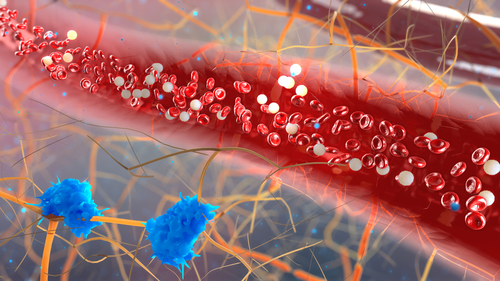A Case of Blood Vessel Inflammation Going from ANCA Antibody-negative to Positive
Written by |

Some blood vessel inflammation cases stem from a group of diseases collectively known as ANCA-associated vasculitis, while others don’t.
Chinese scientists have discovered a first: a non-ANCA-associated vasculitis case that turned into an ANCA-associated one. Doctors call an ANCA-associated case an ANCA-positive case, and a non-associated case an ANCA-negative case.
At first the 64-year-old woman’s inflamed kidney blood vessels showed no signs of ANCA auto-antibodies, according to researchers at Tianjin Medical University General Hospital. Later on, she developed a broader inflammation that did.
The full name of the acronym ANCA suggests the role that autoantibodies play in these diseases. It is antineutrophil cytoplasmic antibody-associated vasculitis. An ANCA-associated vasculitis is also called an AAV.
In addition to shedding new light on the relationship between ANCA-negative and ANCA-positive vasculitis, the case study highlighted the need for better treatment strategies for ANCA-negative patients, researchers said.
The study, “Myeloperoxidase-antineutrophil cytoplasmic antibody (ANCA)-associated systemic vasculitis developed from ANCA negative renal limited vasculitis,” appeared in the journal Medicine.
Doctors said the case started with a build-up of liquids in the woman’s lower extremities — a condition known as edema. A physical exam and blood work showed no obvious abnormalities, but urine analysis revealed high levels of proteins and blood, suggesting kidney irregularities.
Further analysis failed to detect either of two kinds of ANCA-associated antibodies — MPO or proteinase 3 (PR3) — or other antibodies associated with a kidney disorder.
To try to learn what was causing the kidney symptoms, the team examined samples of her kidney tissue. They discovered kidney inflammation. At that point, the team said, they couldn’t rule out the possibility that it stemmed form ANCA-negative vasculitis.
Doctors gave the patient the high blood pressure medication losartan. Her condition improved for 18 months, with a gradual reduction of urine protein levels and edema. She remained ANCA-negative during the period.
She returned to the hospital with complaints of fatigue, a mild cough, mild pain in both knee, and mild weight loss. This time her blood work showed signs of wider inflammation, with increased levels of the kidney-function marker creatinine in her blood. In addition, her ANCA test was positive. A kidney tissue biopsy confirmed that she had the MPO form of ANCA-associated vasculitis.
Doctors gave the woman methylprednisolone to decrease her creatinine levels. Within three weeks of the start of her treatment, she was ANCA-negative again. A detailed analysis showed very low amounts of ANCA that standard tests were unable to detect.
“The long-time stability of disease with no need of any immunosuppressive treatment and the negative results of multiple tests of serum ANCA almost made us exclude the diagnosis of AAV,” the researchers said. “It was the discovery of the weak ANCA in purified IgG [the most common antibody in blood] that helped us to confirm the diagnosis of ANCA-negative AAV finally.”
Diagnosing ANCA when there is a lack of widespread inflammation can be challenging, largely because it can present features similar to those seen in other disorders.
The Chinese team said they believed the woman’s ANCA-negative status was a “transient stage” in the development of ANCA-associated vasculitis. “Physicians should try their best to detect the ANCA in the diagnoses and treatment of ANCA-negative [vasculitis],” they said.




